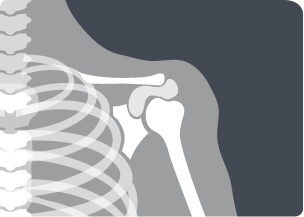Shoulder Replacement surgery will remove damaged parts of the shoulder and replace them with prosthetics. Affected parts of the shoulder include bones and joints, which may need replacing in part or in full.
Pain or injury relieved by Shoulder Replacement include shoulder arthritis, Avascular Necrosis (disrupted blood supply), prolonged rotator cuff tears, and severe fractures.

A complex procedure where the ball and socket joint are replaced with artificial parts. A plastic cup is fitted into the glenoid (part of the scapula) and a highly polished metal ball is attached to the top of the humerus (upper arm bone). Shoulder Replacement surgery is very successful for pain relief and can improve range of motion, depending on individual circumstances and the condition of rotator cuff tendons.
Similar to a total shoulder replacement, parts are replaced with prosthetics but reconfigured in the reverse order. The metal ball is attached to the scapula and the plastic cup to the top of the arm bone. The reason for the reverse order is usually because there is damage to the supporting rotator cuff tendons. Switching positions allows this support to come from the healthy deltoid muscle.
When the socket part of the joint in the scapula is in good condition, but the ball portion on the upper arm bone is damaged, this procedure will replace the ball with a prosthetic and leave the socket intact.
Similar to a Hemiarthroplasty, part of the joint is healthy - in this case, the socket is damaged, but the ball is operating well. This procedure removes the surface of the bone under the ball joint on the upper arm bone, smooths the surface, and a replacement prosthetic is attached.
Many patients stay in the hospital in the days following the procedure and will feel some pain, which is part of the natural healing process and will be treated with medication and ice therapy. You will also be given antibiotics to prevent infection.
Your arm will be in a sling for 2 to 6 weeks, and you will need assistance with some daily tasks for a few weeks, like dressing, bathing, cooking, etc. Most patients cannot drive for up to 6 weeks.
Your doctor will give you a planned rehabilitation program of exercise to begin the day after your surgery, starting with moving fingers, wrist, and elbow.
Follow-up wound care, stitched removal, and evaluations will be planned with your doctor.
If you are looking to book an appointment, please call us on